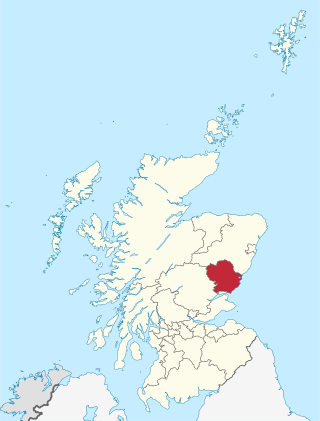
Angus is one of the 32 local government council areas of Scotland, and a lieutenancy area. The council area borders Aberdeenshire, Dundee City and Perth and Kinross. Main industries include agriculture and fishing. Global pharmaceuticals company GSK has a significant presence in Montrose in the east of the county.

A Pictish stone is a type of monumental stele, generally carved or incised with symbols or designs. A few have ogham inscriptions. Located in Scotland, mostly north of the Clyde-Forth line and on the Eastern side of the country, these stones are the most visible remaining evidence of the Picts and are thought to date from the 6th to 9th century, a period during which the Picts became Christianized. The earlier stones have no parallels from the rest of the British Isles, but the later forms are variations within a wider Insular tradition of monumental stones such as high crosses. About 350 objects classified as Pictish stones have survived, the earlier examples of which holding by far the greatest number of surviving examples of the mysterious symbols, which have long intrigued scholars.
Glamis is a small village in Angus, Scotland, located 5 miles (8 km) south of Kirriemuir and 5 miles (8 km) southwest of Forfar. It is the location of Glamis Castle, the childhood home of Queen Elizabeth the Queen Mother.

Aberlemno is a parish and small village in the Scottish council area of Angus. It is noted for three large carved Pictish stones dating from the 7th and 8th centuries AD ; the stones can be viewed at any time in spring-autumn, but are covered by wooden boxes in the winter to prevent frost damage. Two stones stand by the B9134 Forfar-Brechin road, the Kirkyard Stone stands in the nearby graveyard of the parish church.
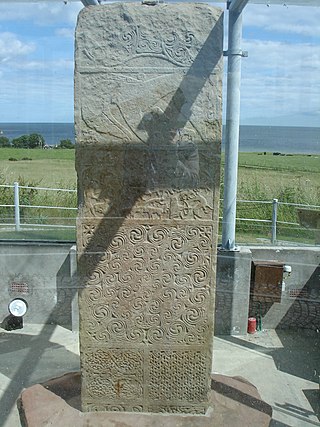
The Clach a' Charridh or Shandwick Stone is a Class II Pictish stone located near Shandwick on the Tarbat peninsula in Easter Ross, Scotland. It is a scheduled monument. Since 1988 it has been encased in a glass cover room.

The Hilton of Cadboll Stone is a Class II Pictish stone discovered at Hilton of Cadboll, on the East coast of the Tarbat Peninsula in Easter Ross, Scotland and now in the National Museum of Scotland. It is one of the most magnificent of all Pictish cross-slabs. Until its felling in a storm in 1674, it faced East - West in a natural amphitheatre about 100m from the shore, which runs NE - SW. Like other similar stones, it can be dated to about AD 800.

Menmuir is a parish in the county of Angus in Scotland.

The Eassie Stone is a Class II Pictish stone of about the mid 8th century AD in the village of Eassie, Angus, Scotland. The stone was found in Eassie burn in the late 18th century and now resides in a purpose-built perspex building in the ruined Eassie church.
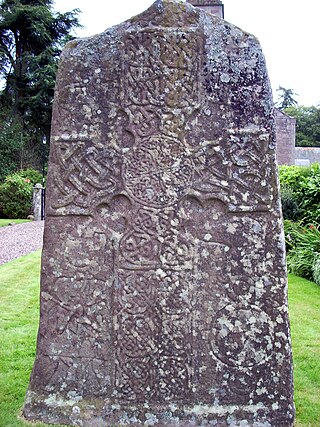
The Glamis Manse Stone, also known as Glamis 2, is a Class II Pictish stone at the village of Glamis, Angus, Scotland. Dating from the 9th century, it is located outside the Manse, close to the parish church. It is inscribed on one side with a Celtic cross and on the other with a variety of Pictish symbols. It is a scheduled monument.
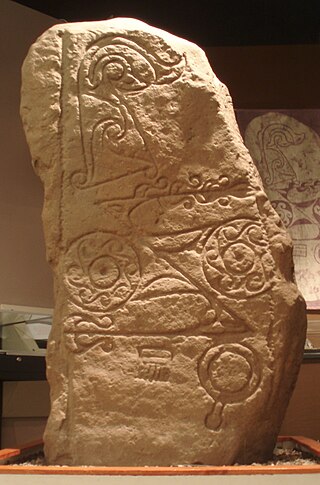
The Dunnichen Stone is a class I Pictish symbol stone that was discovered in 1811 at Dunnichen, Angus. It probably dates to the 7th century AD.

The Monifieth Sculptured Stones are a series of five class II and III standing Pictish stones from the early Medieval period found in or around St Regulus' church in Monifieth, Angus, Scotland. Uncovered during the demolition of a pre-Reformation church and its kirkyard wall in the 19th and 20th centuries, the stones are now housed in the collection of the Museum of Scotland.
The Aberlemno Sculptured Stones are a series of Pictish standing stones originating in and around the village of Aberlemno, Angus, Scotland. Three are located in the village and a fourth, found in 1962, is on display in The McManus in Dundee. They date from the Early Medieval period. A fifth stone standing in the village has signs of carving, but is of unknown authenticity as a Pictish artefact.
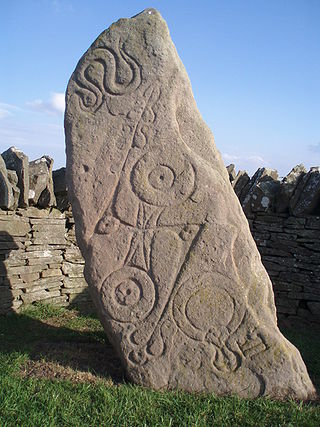
The double disc is a Pictish symbol of unknown meaning that is frequently found on Class I and Class II Pictish stones, as well as on Pictish metalwork. The symbol can be found with and without an overlaid Z-rod, and in combinations of both.

The Woodwrae Stone is a Class II Pictish Stone that was found in 1819 when the foundations of the old castle at Woodwrae, Angus, Scotland were cleared. It had been reused as a floor slab in the kitchen of the castle. Following its removal from the castle, it was donated to the collection of Sir Walter Scott at Abbotsford House. It is now on display at the Museum of Scotland in Edinburgh.

St Orland's Stone is a Class II Pictish Cross-Slab at Cossans, near Kirriemuir and Forfar, Angus, Scotland
Glamis Stone can refer to:

The Kirriemuir Sculptured Stones are a series of Class II and III Pictish stones found in Kirriemuir, Angus, Scotland. Their existence points to Kirriemuir being an important ecclesiastical centre in the late first millennium AD.
The crescent is a Pictish symbol that is found occasionally on its own on Class I and Class II Pictish stones but, overlaid with a V-rod, is the most frequently-occurring symbol. The V-rod never appears on its own and its only other appearance is overlaid on an arch at Migvie. The symbol is found in combination with other symbols, notably with the double disc and z-rod. which is the next most common symbol.
The mirror and comb are Pictish symbols of uncertain function, found on Class I and Class II Pictish stones. The mirror, or mirror and comb, do not belong to the body of main Pictish symbols, but are used as modifiers of a symbol pair. The mirror can occur on its own, or with the comb, although the comb never occurs on its own. The mirror, or mirror and comb, occur either below the symbol pair, or beside the lower symbol.
The triple disc is a Pictish symbol of unknown meaning, that is found on Class I and Class II Pictish stones. The symbol is found in various combinations with other symbols, notably with the crescent and v-rod. The symbol is constructed from a larger central circle flanked with two smaller circles on either side. It is sometimes shown with a "bar" bisecting all three circles.














